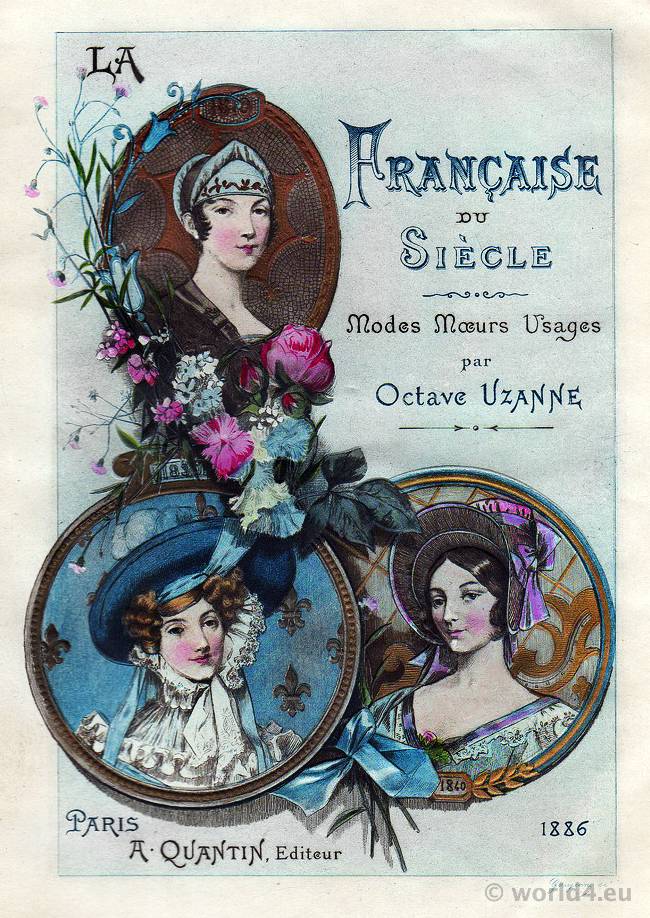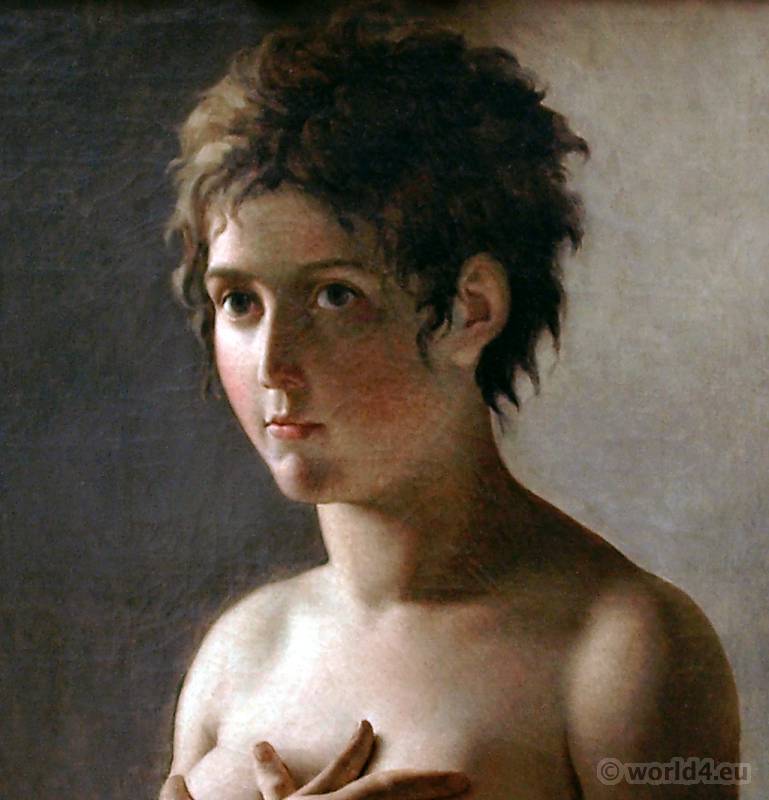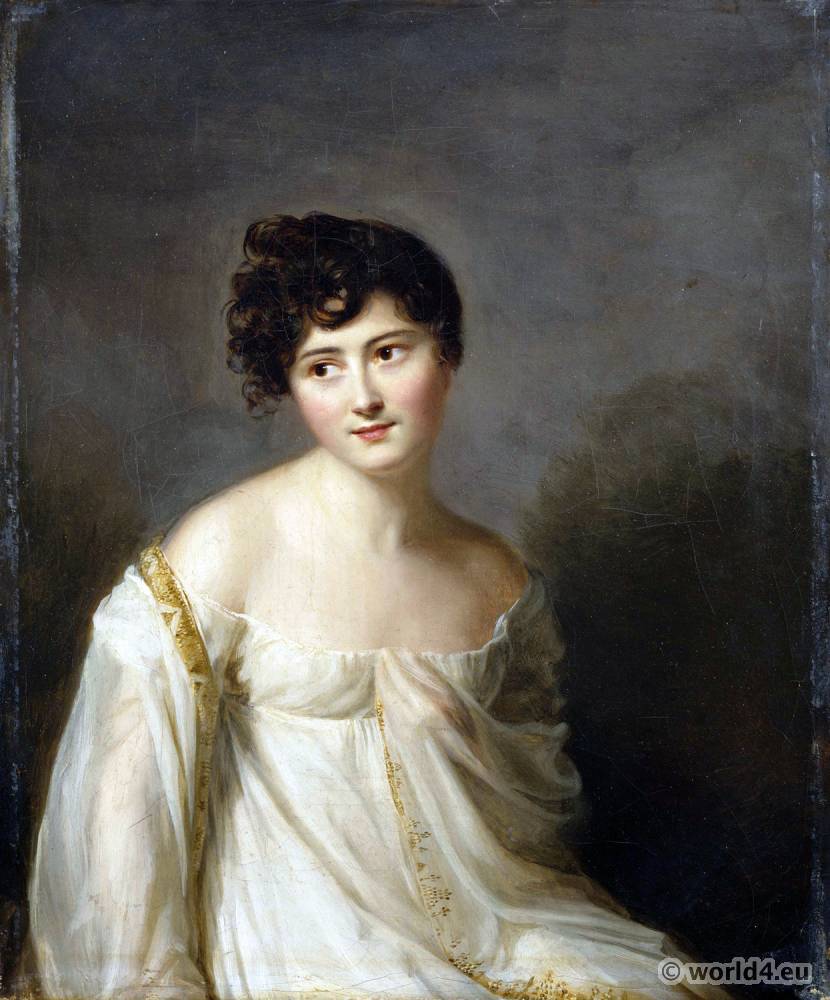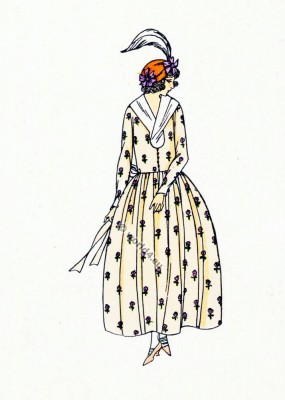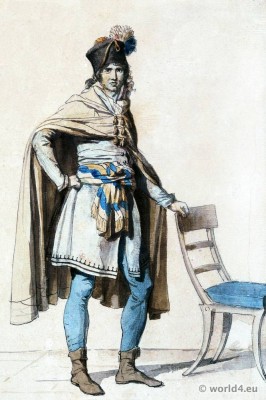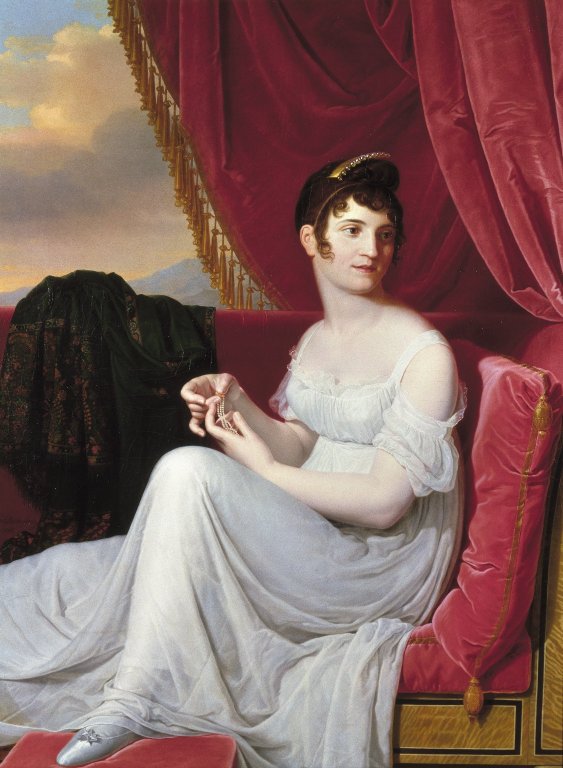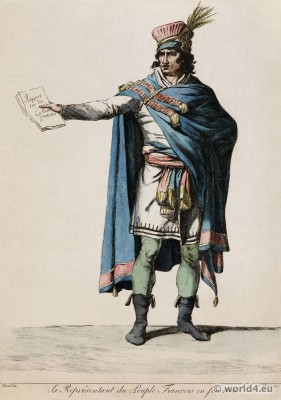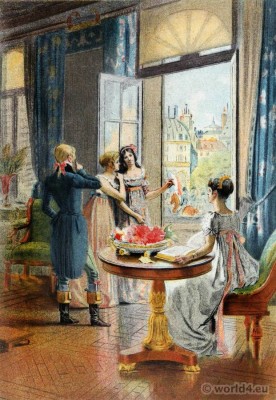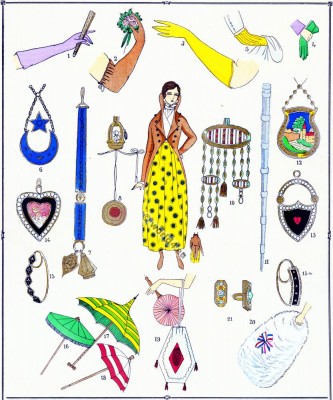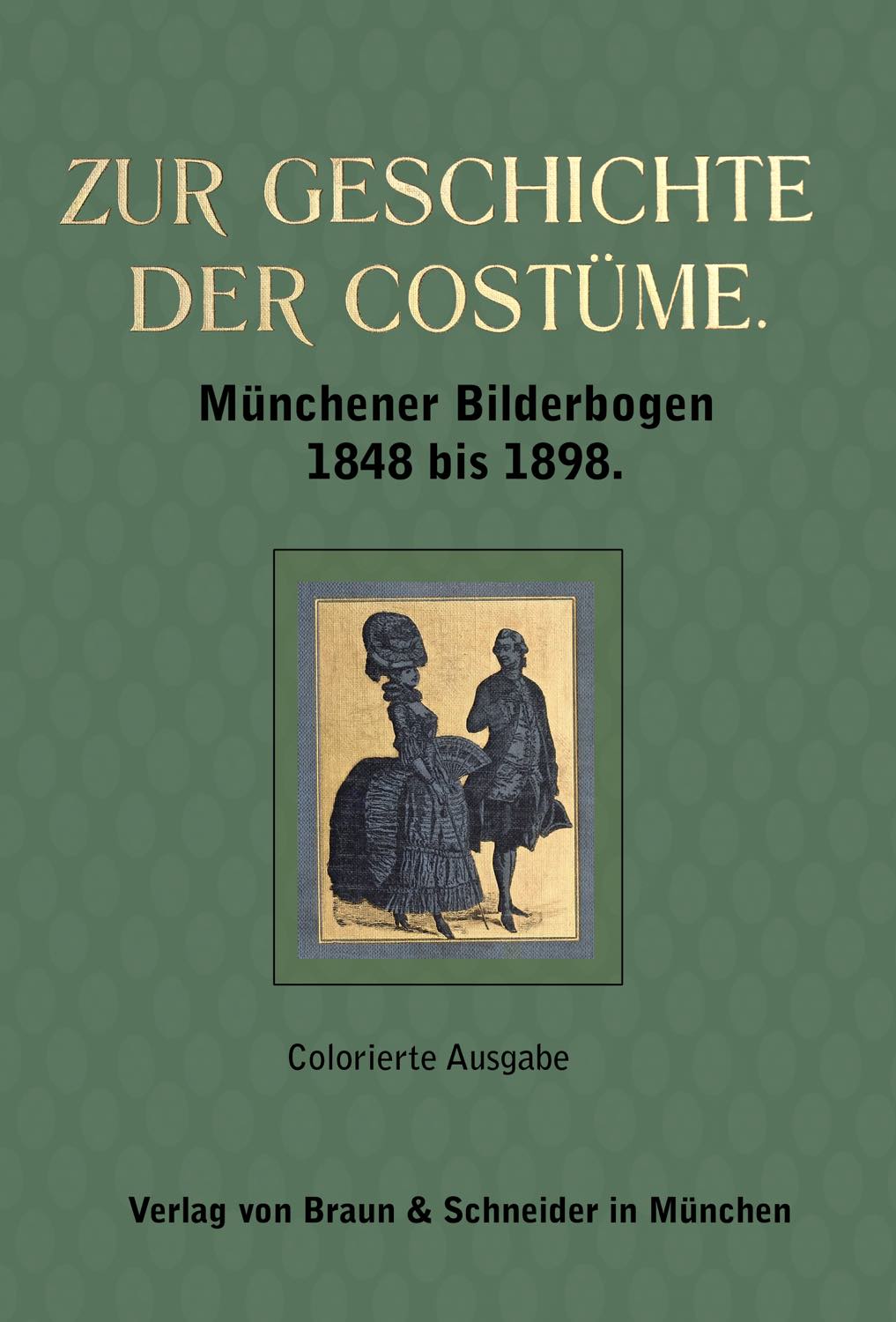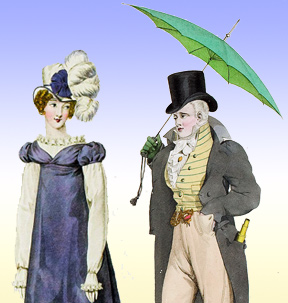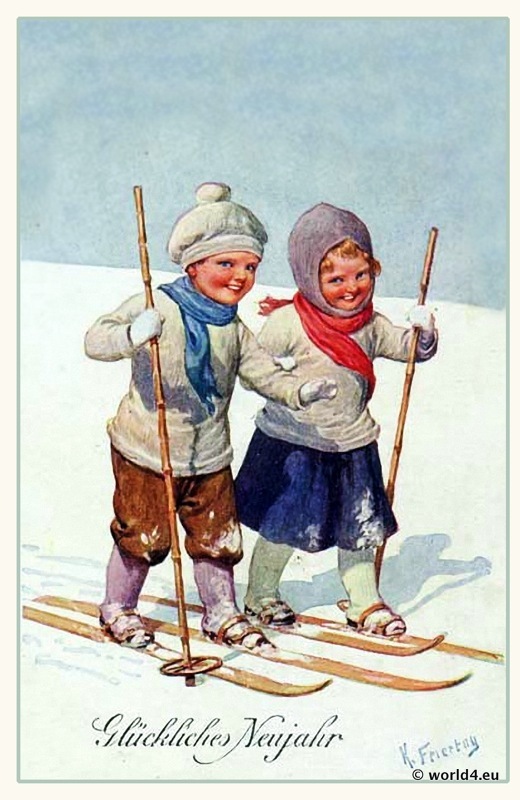Nymphs and Merveilleuses. The Frenchwoman of the century by Octave Uzanne.
- Chapter I., The creation of the Directory.
- Chapter II., The origin of the famous Ball of the Victims.
- Chapter III., The queens of Paris.
- Chapter IV., The true drawing-room of the Directory.
- Chapter V., The Parisian beauties.
- Chapter VI., Anglomanie raged over manners and fashions.
- Chapter VII., The end of the Directory.
The creation of the Directory.
The creation of the Directory. Nymphs and Merveilleuses.
Chapter I.
The nineteenth century awakes
Allow it, for it is the truth; our nineteenth century awakes, is born on the morrow of the 9 Thermidor. Under the Directory, which was, it was wittily said, as the Regency of the Revolution, French society reforms itself in oblivion of the past, carelessness of the future, and the most utter epicurism of the present. Logically, we may say that the frontier of the eighteenth century is cleared, and that a new era commences with all the transformations of manners, language, and customs which mark the normal evolution of France towards a new regime. The public spirit was reposing after the terrible nightmare of the Terror, and one might believe for a moment in the intoxication of that sudden lull, in a complete popular appeasement, in a serious political reparation and a true civil renovation.
Tableau de Paris
Mercier, who then was writing a new Tableau de Paris *, declares that all is changed. “Luxury comes out more brilliant than ever from the smoking ruins, the culture of arts takes again all its lustre; literature, too, whatever one may say, suffered but a passing eclipse… .“ Shows have taken to them again their pomp, and the fashions are again the chief object of idolatry.
“From all parts of the social body,” he continues, “new opulent men have been seen to emerge, and with them gold and riches: so that at the first glance it might be said that the great evils were repaired; but it is not so.“
Paris being a town essentially commercial, essentially skilled, essentially composed of taverns, it might be believed that for her the misfortune which is no longer has never been.
The reaction of Thermidor
A brilliant surface disguises the plaints and veils the murmurs. Luxury is like a spirituous liquor which entirely intoxicates the spirits; and I know not what mobility in opinion makes every one attach himself, for his part, to a sort of epicurism which lets the world slide on, thinking only of the present moment.
“The present moment,” says Mercier at the conclusion of his preface, “already makes an astonishing and perfect contrast with that of servitude, of terror, of disruption of families, of tears and of blood. “If all the disastrous circumstances are not forgotten in the midst of our feasts and our pleasures, they are covered with a curtain which one fears to raise, or rarely raises.” (1)
No contemporary judgment is more exact or more clear than this. The citizen Mercier sums up in it in a marvellous manner the state of men’s spirits in the first days of the Directory. The most perfect anarchy succeeded the “National Razor;” the Revolution had destroyed all, even the empire of women; the clubs, the assemblies of the street had caused to disappear even the last traces of the assembly rooms; all French spirit, grace and finesse seemed to have been submerged in the bloody deliriums of the crowd. The reaction of Thermidor had to create, to institute everything new; it had also the honour to efface the last monstrous recollections of the Terror.
So it is not astonishing to see everywhere the resurrection of pleasure, games and joy, after so long constraint; confusion is in all places; one feels that one lives in a moral interregnum: folly, forgetfulness, drunkenness, abandonment of oneself with facility and without regard for the means, is the order of the day. Woman, above all, knows that she has regained her most charming rights. Nothing had revolted her more, as the citizen Thérémin (2) remarks, than that absurd attempt of the Revolution which was for introducing into our manners the severity or the ferocity of the social laws of the first Romans. Terrified by that austerity calling itself republican, our Frenchwomen strove to give birth to a corruption greater even than that under the monarchy; to reassure us for ever against those false Spartan rigours; they wished only to please, and their seductive power was more mighty than any amount of rigid decrees, than the majority of the measures taken in order to establish virtue and morality.
The creation of the Directory
The creation of the Directory replaced woman on the mythologic throne of the Graces and the Loves, made her the mad queen of a society, panting, feverish, agitated, resembling a fair open to all appetites, to all low passions, to stockjobbing, to loves by auction, to every kind of trade which excluded sentiment, “Look into the drawing-rooms,” write the MM. de Goncourt; (3) “glance over the street: the public promenades, the public balls, these are the drawing-rooms of the Directory, drawing-rooms of equality, with wide open folding doors for every one that comes, for every one that can pay. Pleasure was nothing but a small family feast: it is now a brotherly repast! no more caste! no more rank! All the world amuses itself together and in the open air! society is only at home when not at home! The young girl dances with the first comer; actresses and wives of directors, spouses and courtesans elbow and cross one another! … noise, movement, meetings! It is delicious, it is incredible.”
Letters of a Mameluke
But the art of living, the art of pleasing, the exquisite politeness, that happy mixture of regard and deference, of anticipation and delicacy, of confidence and respect, of ease and modesty, as it is phrased in the Letters of a Mameluke ? Politeness ? it is no longer aught but a prejudice: young men address women with their hats on; does an old man anticipate their requests, the young men ridicule the worthy fellow. You pick up a woman’s fan, she has no word of thanks; you salute her, she returns not your salute. She passes on, ogling the fine youngsters, laughing in the face of the deformed. The woman of the Directory seems to have materialised her spirit and “animalised” her heart; no more sentimentalism, scented and delicate gallantries, but in every meeting direct exchanges of proposals which bring about hasty couplings. It is no longer the forbidden fruit in this paradise of paganism; all the tactics of love consist in provoking desire and satisfying it as quickly as possible. One conjugates the verb after the caprice of the moment: I want you, you want me, we want each other, never passing on to the impersonal, preferring to arrive at once at the imperfect or the past definite. Divorce is there to untie the bonds of those tortured by jealousy, the cynicism of the time has made these delicacies rare. Marriage is no more considered, save as, according to the terrible expression of Cambaceres in the Code, “Nature in action;” that civil act is held but temporary, incompatibility of humour unbinding those whom physical agreements had united.
“From husband to husband” say, strangely enough, the historians of the Directory, “the woman wanders, pursuing her happiness, unbinding and rebinding her girdle. She circulates as a pretty piece of merchandise; she is spouse so long as she is not tired of it; she is mother while it amuses her … . The husband runs from the arms of one to the arms of another, demanding a concubine in a wife, and the satisfaction of his appetite in continual marriages. Divorce occurs for a mere nothing … marriage is its prelude; the husband has no jealousy of the past, the wife has no shame. It seems that the marriages of that time took their model in a stud where a trial is allowed.”
- (1) Paris pendant la Revolution. Preamble of 10 frimaire, an VII.
- (2) Thérémin, De la condition des femmes, an VII. , 1799, Charles-Guillaume Théremin; préface de Marie-France Silver. Published 1996 by Indigo & Côté-femmes éditions in Paris.)
- (3) E. and J. de Goncourt, Histoire de la société française pendant le Directoire, ch. iv.
- With his “Tableau de Paris,” Louis-Sébastien Mercier has discovered the city as a social cosmos and described with empathetic devotion and sharp wit. A fascinating insight into the literary life in Paris before the Revolution. Mercier is the first big-city reporter in history.
The Ball of the Victims. Nymphs and Merveilleuses.
… the pleasures of the dance the survivors of the Terror.
According of to the author of the Souvenirs thermidoriens (1) the dancing reaction was sudden, impetuous, formidable, on the morrow of the deliverance. Scarcely were the scaffolds thrown down—the cesspool of the Barrière du Trône still exhaled the fetid odour of the blood shed there — when balls began to be organised in all points of the capital: the joyous tones of the clarionet, the violin, the tambourine, the flute, called together to the pleasures of the dance the survivors of the Terror, who flocked thither in crowds. Duval, in his Souvenirs, enumerates plentifully these different temples of Terpsichore:—” Here is first the magnificent garden of the Farmer-General Boutin, executed with all his colleagues, for having mixed water with the state tobacco, which the proprietors baptized with the Italian name of Tivoli.
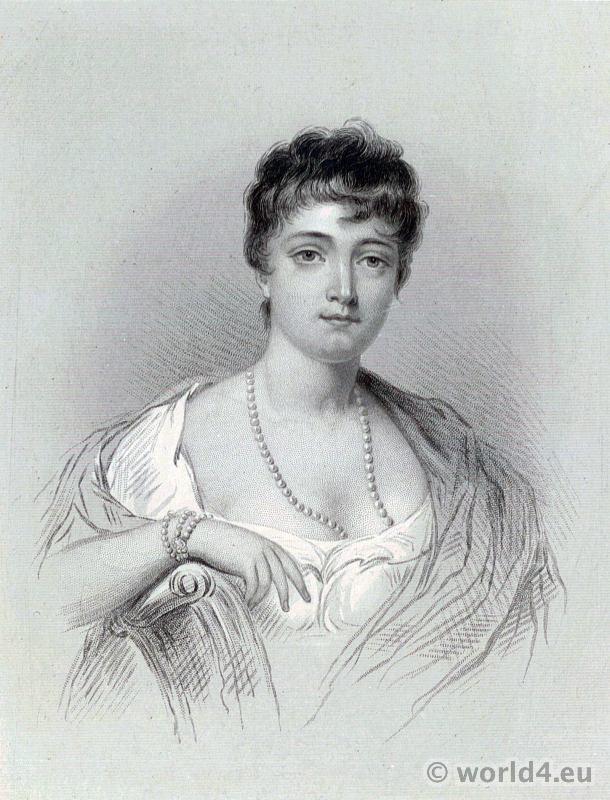
This was the first which opened its gates to the public. Another ball was established in the Jardin Marbeuf, at the end of the avenue of the Champs-Élysées. Gay dances were the rule in these two places, and none dreamed that the ashes of those who had created these enchanting gardens, and been afterwards reaped by the revolutionary sickle, were yet hardly cold.”
The famous Prado.
Other balls were opened in succession: the ball at the Élysée National, once upon a time Bourbon, of which the negro Julien directed the orchestra with rare happiness, the Musard of his time; delicious boating excursions were here the rage; the Ball of the Jardin des Capucines, frequented by the milliners of the Rue Saint-Honoré and the Rue Neuve-des-Petits-Champs; the Ranelagh of the Bois de Boulogne, abandoned at that time to the clerks of pettifogging lawyers and tradesmen; the Wauxhall, where the skilful feats of the juggler Wal made the grisettes of the Marais and the Ouartier du Temple flock together; all these balls were open on the quintidi and the décadi to the middle classes.
Frascati and the Pavilion de Hanovre were the rendezvous of the high classes of society. In the city there was the Bal de la Veillée, where marvellous caterwauling concerts were given. Some twenty cats, of which one saw the heads only, were disposed on the keys of a harpsichord: these keys were pointed blades, every one of which struck the tail of a cat who emitted a cry, every cry answered to a musical note, and the whole produced an admirable charivari. This Bal de la Veillée became afterwards the famous Prado, dear to students.
The Bal des zéphirs.
On the left bank of the Seine one met with the Ball of the Rue Théouville, formerly Dauphine; then opposite the north gate of the Church of Saint Sulpice, at the entrance of the Rue Servandoni, one saw, balancing itself gracefully in the air, softly moving to and fro, a transparent rose, bearing the inscription, Bal des zéphirs.
This ball, where the flute bore sway, had been established in the ancient cemetery of Saint Sulpice; this legend was still to be traced on the ground, Hic requiescant beatam spem expectantes.
The corybants of the Dance of Death.
The tumulary stones were not even removed from the interior of this place of pleasure; but the dancing youth cared little about profaning the ashes of the dead, and madness shone with all its lustre in that necropolis. Rue d’Assas, near the ancient convent of the Carmes Déchaux, in the very cemetery of the priory, was another carmagnole: the Bal des Tilleuls was opened there. The corybants of the Dance of Death came thither in crowds.
The origin of the famous Ball of the Victims
The dancing epidemic increased from day to day. After the decree, carried on the proposition of Boissy d’Anglas, which restored to the heirs of the condemned their confiscated property, joy returned to the camp of the disinherited, who passed thus suddenly in a few days from misery to opulence. These young people, astounded by the return of fortune, rushed into all the pleasures of their age; they founded an aristocratic ball for themselves alone, and decided to admit only those who could boast of a father, mother, a brother or sister, or uncle at the least, immolated on the Place de la Revolution, or at the Barrière du Trône. Such was the origin of the famous Ball of the Victims (Hôtel Richelieu), which possessed a ceremonial of its own, and introduced veritable innovations into the eccentricities of fashion.
On entering the ball, one saluted à la victime with a quick movement of the head, imitating that of the condemned at the moment when the executioner, poising him on the plank, passed his head into the fatal crescent. There was an enormous affectation of grace in this salute which every one studied at his best; some young heroes of quadrille introduced into it an elegance which caused them to be received by the feminine Areopagus with marked favour. Every cavalier invited and reconducted his partner with a salute à la victim; nay, to accentuate this infamous comedy, some of the most refined elegance bethought themselves of having their hair shaven on the nape of their, after the same fashion as that in which Samson served those who had been condemned by the revolutionary tribunal.
This ingenious invention caused transports of admiration in the camp of this extravagant youth. The ladies followed the fashion, and resolutely had their hair cut off at the roots. Such was the birth of the coiffure à la victim, which was to extend through all France and be called subsequently coiffure à la Titus, or à la Caracalla. To complete this heartrending buffoonery, the daughters of those who had suffered adopted the red shawl in remembrance of the shawl which the executioner had cast over the shoulders of and the ladies Sainte-Amarante before mounting the scaffold.
This Ball of the Victims, in consequence of its madnesses and its high society, became very soon an object of ambition for happy Paris; people went there to see the fashions of the day, for the young girls who came thither in the evening to dance the new waltzes, rivalled one another in their toilets and their graces …; little by little they quitted their mourning and boldly hoisted satin, velvet, and cashmeres of the warmest tones. It was at these insolent reunions that the first Lacedemonian tunics appeared, and the chlamydes with meandering colours, the fine calico shirt, the robes of gauze or of lawn, and the buskin with its charming interlacings of ribbons on the instep; all the fancies, Greek and Roman, which we shall hereafter describe, were Inaugurated, for the most part, by the descendants of the guillotined. A few amiable arch-shorn ladies carried their love of realism and horror so far as to fasten round their neck a small red collar, which imitated most ravishingly the section of the chopper. The Incredibles swore in their affected style, by their little word of honour striped, that it was divine, admirable, flowing with unheardofness.
In the intervals of the quadrilles, ices, punch, sherbets were swallowed down, partners’ hands were taken, and declarations of love were received; nay, if we may believe an eye-witness, the author of the Souvenirs thermidoriens, “they ended by agreeing among themselves that after all Robespierre was not so black as he was painted, and that the Revolution had its good side.“ (2)
Nothing was wanting to these madmen but to sing, in imitation of the beautiful Cabarus (Thérésa Cabarrus-Tallien 1773-1835, Madame “Notre-Dame-de-Thermidor”), the couplet of a satirical song then half-celebrated among the Directors:
Robespierre returns; how fain.
Would we to dance our dears be calling!
The Terror will be born again,
And we shall see the heads afalling!
But no! though hearts with longing yearn,
Robespierre will not return!
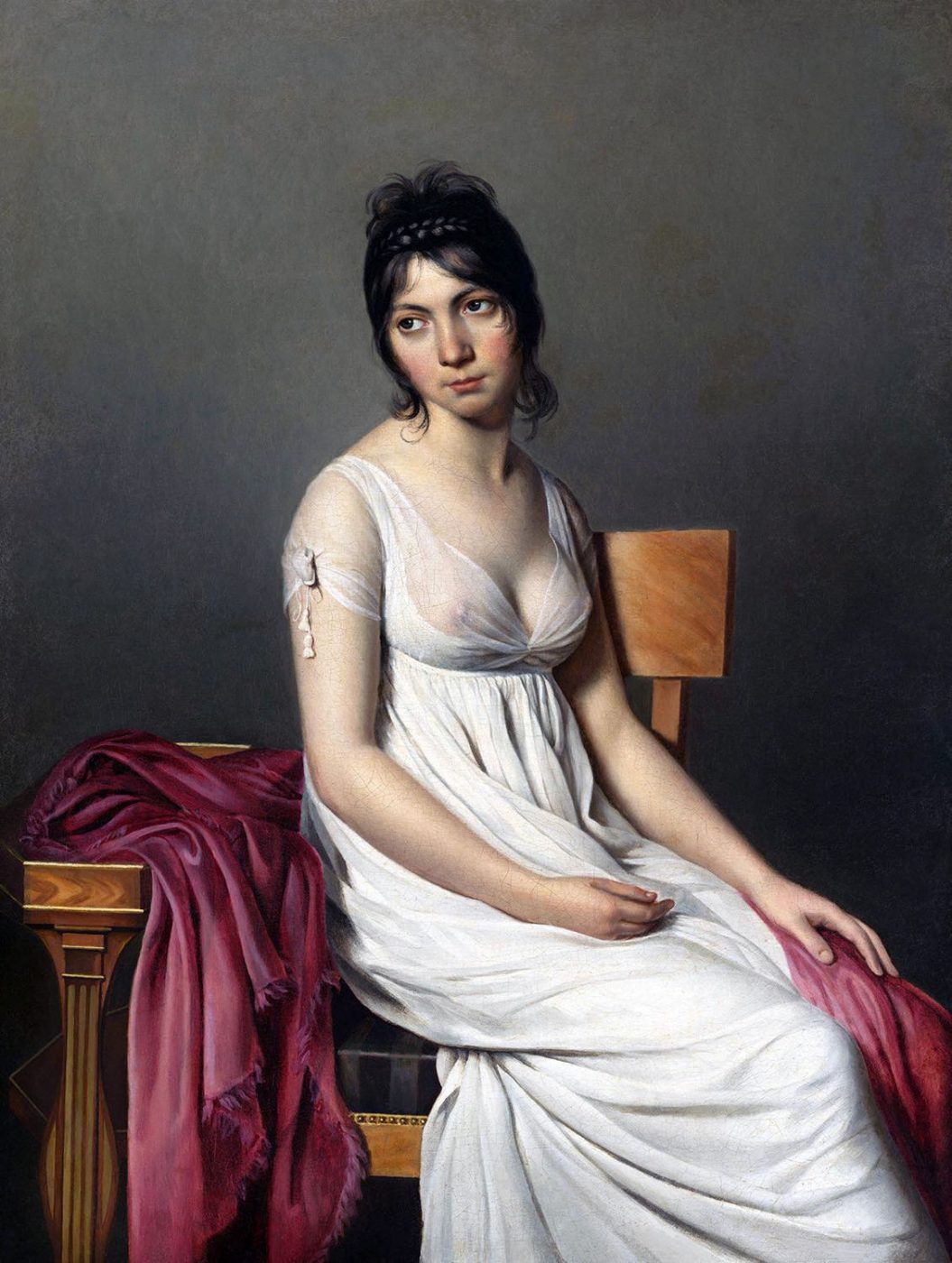
Beside the Ball of the Victims all Paris paid the piper; it was a general whirl; one capered by subscription at the Bal de Calypso, Faubourg Montmartre, at the Hôtel d’Aligre and the Hôtel Biron, at the Lycée of the Bibliophilists and Novelists, Rue de Verneuil; in the Rue de l’Échiquier at the florist Wenzell’s; in every street of the city. Good society came by preference to the Hotel Longueville, where the fair Madame Hamelin disdained not to show her nonchalant graces. “In these sumptuous saloons,” write MM. de Goncourt (The Goncourt brothers Edmond 1822–96 and Jules 1830–70, French naturalism writers. Novel Sister Philomilne), “the bow of Hulin commands, and a whole world undulates to prolonged accompaniments of bodies which syncopate two measures.
Three hundred women, perfumed and floating in their déshabillés as Venus, allowing people to see all that is not shown, immodest:” fine leg, roguish foot, elegant bust, wandering hand, bosom of Armida, form of Callipyge, “in the arms of vigorous dancers turn, turn and turn again, knotted to their Adonises, who extend an unwearied thigh, marked out by supple nankeen. Under the cornices of gold a thousand mirrors repeat the smiles and interlacings, the swept garments moulding the body, the breasts of marble, and the mouths which, in the whirlwind of intoxication, open and blossom like roses.”
All these classes of society are galvanized by the dancing mania; there is twirling even in the miserable garrets of the Faubourgs; many bals champêtres were arranged in the caverns of restaurant-keepers, in the underground floors of tradesmen.
(1) Souvenirs thermidoriens. By Georges Duval, author of the Souvenirs de la Terreur. Paris: Victor Magen, 1844, torn. ii. chap. xiv. Duval, in the course of this chapter, gives about the balls of Paris during the Directory very curious details not to be found elsewhere. We have borrowed many characteristic notes from these descriptions, which are those of an eye-witness.
(2) Ripault, in Une journée de Paris, an V., also shows us an eyewitness, who is Polichinelle, at the Ball of the Victims: “I saw a fine young man, who said to me, ‘Ah ! Polichinelle … they have killed my father!— They have killed your father?’— and I took my handkerchief from my pocket—and he began to dance.”
The Revolution had submerged everything.
Never did the French nation offer to the eyes of the observer a spectacle more strange, more incoherent, more varied, more inconceivable, than that which it presented at the beginning of the Directory. The Revolution had submerged everything— traditions, morals, language, throne, altar, fashions and manners; but the specific lightness of the people swam on the top of all these ruins; the spirit of carelessness, of romancing, of pertinency, that never-dying spirit, grumbling and laughing, precious foundation of the national character, reappeared on the morrow of the storm more alert, more vivacious, more indomitable than ever. As nothing remained of the past, and as it was impossible to improvise in a day a society with its harmonies, its usages, its garments entirely unedited, they borrowed the whole from ancient history and nations which have disappeared.
Everybody muffled himself, played the part of old lady or gentleman, all took the disguise they liked; it was a general travesty, an unlimited carnival, an orgie without end and without reason. One cannot regard, at the present day, this epoch as a whole, and in the minute details of its working, without believing in an immense mystification, a colossal caricature composed by some humorist of the school of Hogarth or Rowlandson (William Hogarth 1697-1764, Thomas Rowlandson 1756-1827). Still, in despite of these Parisian follies, our armies of Sambre-et-Meuse, of the Rhine and of the Moselle, as well as our glorious battalions of Italy, carried wide the renown of our arms and the germs of liberty; the whole world re-echoed our victories; the prodigies of Bonaparte disquieted old Europe, and one might have thought that so much glory was capable of giving at once pride and wisdom to the dancing jacks which had made of Paris a dazzling puppet-show impossible to describe! Nothing of the kind.
Bad taste was flagrant.
We can scarcely believe that, in the midst of the victories of Ney, of Championnet, and of the General Bonaparte, no enthusiasm was perceptible in the capital, on our boulevards and public places not a single movement of joy. If we may credit the contemporary journals, people passed coldly, with the most complete indifference, beside the criers who announced the greatest successes of our generals; it was peace that was desired, tranquillity, abundance. Stockjobbing had gained all classes; the drunkenness of the masquerade annihilated noble ideas in every brain. The Écrouelleux, the Inconcevables, the Merveilleux, with their chins hidden in their inordinate cravats, cursed the Government of the Directors, misunderstood the merits of our soldiers, saying, with their fastidious air.
On the word of a victim, this cannot last! The fêtes even, given by the Directory to render homage to the valour of our brave men, were sometimes without dignity and true grandeur; bad taste was flagrant, and the comedism of these ceremonies did not exclude ridicule. When Junot came to the Government with the colours taken at the battle of La Favorite, he was received, like Murat, with grand preparations; but the aide-de-camp Lávallette, in a letter to an intimate friend, relates with what pomp more modest receptions were usually managed. “I have seen,” he wrote, “in the apartments of the petit Luxembourg, our five kings, clad in a mantle of Francis I., bedizened with lace, and wearing on their heads a hat of Henri IV.
The figure of La Revellière-Lépeaux (Louis-Marie de La Révellière-Lépeaux 1753-1824 was a politician during the French Revolution and 1795-1799 Member of the Executive Board.) looked like a cork fixed on a couple of pins; M. de Talleyrand (Charles-Maurice de Talleyrand-Périgord 1754-1838, was one of the most famous French statesman and diplomat during the French Revolution, the Napoleonic Wars and the Congress of Vienna. For his services he received several noble title: 1806 Prince of Benevento, 1807 Duke of Talleyrand-Perigord and 1815 Duke of Dino) in silk pantaloons of the colour of wine dregs, seated on a folding-chair at the feet of Barras, presented gravely to his sovereigns an ambassador of the Grand Duke of Tuscany, whilst the General Bonaparte was eating his master’s dinner.
On the right, upon a dais, were fifty musicians and singers of the opera, Lainé, Lays and the actresses, singing a patriotic cantata to the music of Étienne-Nicolas Méhul (1763-1817); on the left, upon another dais, two hundred women, with the beauty of youth, freshness and nudity, going into ecstasies over the happiness and majesty of the Republic; all dressed in muslin tunics and silk tights, after the fashion of opera dancers; the majority of them with rings on their great toes. On the morrow of this fair festival thousands of families were proscribed in their heads, forty-eight departments were widowed of their representatives, and thirty journalists went to die at Sinnamary on the borders of the Ohio!” (1)
The Festival of Spouses
Besides the fêtes dedicated to victory, the Government of the Directors had, after ancient usage, instituted public festivals at fixed dates, in honour of the Republic and of its foundation; others were consecrated to the Fatherland, to Virtue, to Youth; there was even the Festival of Spouses, a strange idea in a time when divorce was the rage, and when one would never have dreamed of raising the smallest shrine to Fidelity and still less to Constancy.
The Luxembourg, of which the five Directors had taken possession, had become, as the poet Arnault (Antoine-Vincent Arnault 1766-1834 Souvenirs d’un sexagénaire, 4 vols. 8vo, 1833.) remarks, a veritable Court; and as that court was very accessible to women, thanks to the voluptuous Barras, these had brought their sweetest manners. Gallantry had caused to disappear, little by little, the Republican austerities, and women were recovering in a great measure the empire of which they had been dispossessed during the long reign of the Convention.
The queens of Paris
The citizenesses Madame de Staël (Anne Louise Germaine de Staël-Holstein 1766-1817), Hamelin (Fortunée Hamelin, Jeanne Geneviève Fortunée Lormier-Lagrave à Saint-Domingue, 1776-1851), de Château-Regnault, Bonaparte and Tallien (Thérésa Cabarrus, Madame Tallien 1773-1835, “Our Lady of Thermidor”) were the queens of Paris, and there were no festivals without them. The daughter of the Count de Cabarrus, the ex-spouse of Monsieur de Fontenay, the future wife of the Count de Caraman-Chimay, the beautiful Madame Tallien, in a word, seemed above all the uncontested sovereign of the Directorv, and there might have been attached to the hem of her Roman costume that satirical label, Respect to the national proprieties. A witty remark was told at this time which circulated for a long while in that frivolous society: a dandy had attached himself to the steps of the great citizeness, and as she languidly turned towards him, “Your reason, sir, for regarding me?” “I regard not you, Madame,” the wag replied, “I am examining the crown diamonds.“ (2)

“This woman,” write the portrait-painters of the Directory (3) with too much enthusiasm, “is the fairy of the Luxembourg. She adorns its ceremonies with her smile. She organises its parties and its galas. She changes, metamorphosis herself to restore their youth to its fêtes and give them a new attraction. Sometimes it is Calypso receiving the friends of Tallien in her cottage of Cours-la-Reine, and promenading them under the canopies of verdure interlaced with emblems, among the trees, as the nymph of the god; at the Palais de Suresnes she is a countrywoman of Frascati, a goddess disguised who betrays herself in her walk! As a light sceptre, with which her fingers trifle, she holds in her hand the superintendence of taste, and by her the pianofortes of the civil list, of which the melodies had been allowed to slumber, are distributed to the fair hands worthy of awaking them. Through her the directorial mansion is filled with collections of music of Marie-Antoinette, Madame Victoire, Madame Élisabeth (Élisabeth Philippine Marie Hélène de Bourbon, called Madame Élisabeth 1764-1794 executed in Paris. She was the youngest sister of King Louis XVI.), Madame de Bombelles (Marie-Angélique Mackau 1762-1800). She is among the five kings obeyed like a Grace who rules after her slightest will; her example is authority for the detail and decoration of their interiors; does she doat on porcelain of Sèvres, ministers and directors at once have a tea-service upon their tables.
“Who does not applaud her in all which she commands and all which she dares,” continue the brilliant painters of that society,” who does not applaud her in her singing, who does not applaud her in her dancing, that Sempronia who reposes the tired eyes of Catilina, and conspires only for amusement? All her spirit has been turned towards pleasure, and the harp, the triumph of her beautiful arms! and the southern tongues, music of the voice! she knows all that enchains the looks and the ears… . Her face is embellished with a charm which is found in none other. Circé! who in the time of the scaffolds and red bonnets obliged the executioners to powder themselves with the powder of clove-gillyflower, and who to-day, in the cortège of shirt frill and breeches, with rosettes of Fréron and his golden youth, leads, smiling, the choir of the scandals of France.”
One may add to this radiant portrait that the ci-devant Madame de Fontenay showed always before all the disinherited an inexhaustible charity, a thing which caused it to be said with reason that if the citizeness Bonaparte had acquired the surname of Notre-Dame des Victoires, the charming Tallien merited in every way that of Notre-Dame de Bon Secours.
The most striking drawing-room of the Luxembourg, that where the best company used to meet, was incontestably that of Barras (Paul-François-Jean-Nicolas, vicomte de Barras 1755-1829 Member of the Executive Board, President of the National Convention.). He was simple and full of bonhomie; there was little conversation with that spirit of talk of former days, but there was laughter, play, and unrestrained pleasantry. Monsieur de Talleyrand sat there complacently at a table of bouillotte. Madame de Staël came thither to whisper with Marie-Joseph Chénier, or François de Neufchâteau.
The other Directors received each one day of the decade, but their receptions were not striking.
At La Révellière-Lépeaux’s — Laide peau, as he was nicknamed — the vulgariser of théophilanthropie, nothing was talked of but the new religion, and one’s “vices were put to the torture.” At Carnot’s, who gave miserable soirées in a swell room with a low ceiling, a few warlike ariettes were sung, and the only oath was by the “Evangel of the gendarmerie.” At Letourneur’s and Rewbell’s it was still worse: there was no talk, nothing but yawns. But all France was not at Paris; it was represented above all at the Palais Serbelloni in Milan, and at the Chateau de Montebello, where a brilliant court was eager to render homage to the seductive Josephine, who by her grace made no fewer conquests than her illustrious spouse by his genius.
(1) Decree of the Executive Directory, Paris, 18 fructidor an V., which ordered the arrest of thirty-two directors of journals, who were for the most part transported to French Guiana. Free Ebook: Voyage à Cayenne et chez les anthropophages, by Louis Ange- Pitou, Paris, an XIII. (1805).)
(2) Petite paste. Nivôse an V.
(3) La société française sous le Directoire, chap. x.
The true drawing-room of the Directory
The true drawing-room of the Directory is the street, the Petit Coblentz, Tivoli with its forty acres of verdure, Monceaux, Idalie, Biron, the Élysée; it is, in fine, the Butte Montmartre, whence every evening at night soar ten artificial fires, which shake over Paris their sheaves of jewels, their spangles of gold and emeralds. The street is the eternal holiday, along which defile every night on their way to Feydeau and other spectacles the elegant bands of stockbrokers and contractors in the company of their mad mistresses.
The ancient garden of Boutin
In summer, pleasure is to be found under the foliage at Bagatelle, at the Jardin de Virginie, Faubourg du Roule, at the late Hôtel Beaujon; the aimables and the Merveilleux dote on these turfy spots, full of streams, cascades, grottoes, turrets, Hat with red flames, filled with the noise of trumpets, where half-naked nymphs fly not under the willows. The grand attraction is, above all, the ancient garden of Boutin; it is Tivoli, medley of slopes, miniature waterfalls, sinuous paths, where one passed in the midst of a hedge of pretty women, where all the games known to Cythera were enjoyed. In this country of Astraea, enlivened by the pyrotechnic fancies of the Ruggieri, by caperings, by light songs, by fair-shows, by acrobats of every kind, the society of the Directory found itself in the midst of its carnival.
The fine days which follow those of Robespierre
“Burning pleasures,” wrote Mercier, “women are in their element in the midst of your tumult! Content pierces through their demeanour in spite of their terrible railing against the present time; never have they enjoyed such license among any people; the rudeness even of the Jacobins expires before the ladies without a cockade. They have danced, drunk, eaten; they have deceived three or four adorers of opposite sects with an ease and frankness which would make us believe that our century has no more need of the slightest shade of hypocrisy and dissimulation, and that it is beneath us to palliate our habits and our tastes whatever they may be. “What noise is that we hear? Who is this woman preceded by applause? Come and see. The crowd presses round her. Is she naked? I am in doubt. Come still nearer; this deserves my pencil. I see her light pantaloons, comparable to the famous skin breeches of Mgr. le comte d’Artois, whom four great lackeys raised in air to let fall into his vestment, so that there should be no crease.
Clothed in this box all day, it became necessary to unbreech him in the evening by raising him in the same manner and with still greater efforts. The feminine pantaloons, I say, exceedingly tight although of silk, surpass perhaps the famous breeches by their complete closeness; they are trimmed with a sort of bracelets. The jacket is cut sloping in the most skilful fashion, and under a gauze, artistically painted, palpitate the reservoirs of maternity. A chemise of fine lawn allows the legs and thighs to be seen, which are embraced by circles of gold and diamonds. A crowd of young people environ her with the language of a dissolute joy. Another daring feat of Merveilleuse, and we might see among us the antique dances of the daughters of Laconia; there remains so little to let fall that I know not if true modesty would not be a gainer by the removal of that transparent veil. The fleshcoloured pantaloons, applied straitly to the skin, excite the imagination and allow to be seen only at the best the most hidden forms and allurements; … and these are the fine days which follow those of Robespierre!”
The ancient Hôtel de Richelieu
In the autumn, concerts, teas, theatres attracted the same affluence of transparent robes and muffled chins; there is dancing and taking of ices at Garchy’s and Velloni’s; the Pavilion de Hanovre is all the rage: in this part of the ancient Hôtel de Richelieu, goddesses crowned with roses, perfumed with essences, floating in their robes à l’athénienne, ogle the incroyables, play with their fans, pass to and fro in a whirlwind, laughing, tumbled, seductive, with loud words and insolent eyes, seeking the male.
In the assembly of the men everybody is yelping, and revealing the secrets of the Government. “All these women you see here,” says a young Spartiatus to his neighbour… ” Well?” “They are kept by the deputies.” “Indeed!” “This girl, with dancing eyes and elegant shape, is the mistress of Raffron, he who proclaims the cockade to be the fairest ornament of a citizen. This young lady, with her bosom naked, but elsewhere covered with diamonds, is the sister of Guyomard; his last motion was paid with the crown diamonds. That flaring blonde you see in the distance, is the youngest daughter of Esnard, who has put aside a hundred thousand crowns for her portion; she is to be married to-morrow. There is not,” concludes the young man, “a single member of the legislative body who has not here two or three women, every one of whose dresses costs the Republic a portion of its domains.”
The women of the Directory
Thus the talk intermingles, talk of gallantry, of merchandise, of politics, of stockjobbing, quips and puns. All opinions, all castes, found themselves united in these subscription societies, where one hailed M. de Trénis, the Vestris of the rooms. Women of the higher class, who feared to display luxury and attract attention in receiving habitually at their own homes, had no hesitation about mixing with the gallant nymphs who frequented even Thélusson and the Hôtel de Richelieu. People went there in full dress, but, by instinct, they preferred undress.

Thélusson, Frascati, the Pavilion de Hanovre, were composed very nearly of the best society of Paris, according to Madame d’Abrantès (Laure-Adelaide Abrantès, or Laure (Laurette) Junot, Duchesse d’Abrantès, (born Permond 1784-1838 was a maid of honor at the Napoleon courtyard and a French writer). They went there in a mass after leaving the opera or any other spectacle — sometimes five-and-twenty of the same society; old acquaintances were met there, afterwards they returned late to take a cup of tea… a tea containing everything from stewed fowl to peas and champagne.
The women of the Directory, however, had none of the delicacies and the languid graces which constituted afterwards what was called distinction. Nearly all of them were bouncing girls, manlike, plain-speaking, of a carnation verging on the purple, of overflowing embonpoint, of tuckers suited to gross appetites, of gluttonous greediness ruled by their senses, however they affected sudden faintings or megrims which they never knew. The time to see them was after the concert, falling upon their supper, devouring immense mouthfuls of turkey, cold partridges, truffles and pâtés of anchovies, drinking wines and liqueurs. Eating, in one word, according to a pamphleteer, for the fundholder, for the soldier, for the clerk, for every employé of the Republic. Were they not bound to make a “strong box” to resist the inflammations of the lungs which laid wait for them at their departure? The winter blast soon got the better of a robe of lawn or a roguish tunic au lever de l’aurore.
The Merveilleuse and the Nymph.
The Merveilleuse and the Nymph are, indeed, the typical creatures of this epoch of profound corruption and open libertinage, in which all minors emancipated themselves, and which proclaimed the Sacrament of Adultery. Merveilleuses and Nymphs were the divinities recognised at the décadis and all the pagan festivals of the Republic; plastic beauties, priestesses of nudity and the god of the gardens, women doating on their body from which the soul had deserted, lost in a false mythology which induced them to Grécise for love of the antique until they were able to compare themselves to the Venuses of statuary and the heroines of Fable.
Description of Incroyables.
The young men of fashion were their worthy partners. Listen to a contemporary who shall sketch their portrait in a few lines: ” Presumptuous more than youth ordinarily is; ignorant, since for six or seven years education had been interrupted, following up gallantry with license and debauch, picking quarrels more than would be allowed to men living continually in bivouac, inventors of a jargon almost as ridiculous as their immense cravat, which seemed half a piece of muslin wound about them, and, above all, stupid and impertinent. At war with the royalist party of the Club de Clichy, they adopted a costume which differed at all points from that of the young aristocrats: a very small waistcoat, a coat with two large swallow-tail flaps, pantaloons of which I could have made a dress, small boots à la Souvarow, a cravat in which they were buried. Add to this toilet a little cane in the shape of a club, about as long as half your arm, a spying-glass as big as a saucer, hair frizzled in little snakes which hid their eyes and half their face, and you will have an idea of an incroyable of this epoch.” (Pen-Portrait of an Incroyable by Honore de Balzac.)
After the coiffure à la Titus.
For the Merveilleuses, let us look at them at the date of the year V., when were re-established New Year’s Day presents, and that promenade de Longchamps, of which the defile was nothing but a contest of luxury and beauty, and an incredible rivalry of dress. We shall be able to trace them thus, through the éphémérides of fashion, up to the last years of the century. Nothing less French than the attire of fashionable women at this commencement of the year V. It is nothing, according to the messengers of fashions (Variations des costumes français at the end of the eighteenth century.), but Greek tunics, Greek buskins, Turkish dolmans, Swiss caps—all speak of travellers disposed to travel. That which ought not to surprise us less, after the Titus, the head-dresses à la victime and à l’hérisse, is the blind preference accorded to wigs. Formerly, at the mere name, a fair one would shudder; but the sacrifice of one’s hair in that republican year had become a triumph… ; with that, dress tucked up as far as the calf: this easy style, in accord with flat shoes, crave to women a decided and masculine walk little in harmony with their sex.
The birth of caps gathered in folds.
On their coiffures was set a coquettish biggin, like enough to the caps of infancy, or else a spencer hat with high crown fluted with vultures’ feathers. The same year witnessed the birth of caps gathered in folds, the child’s cap trimmed with lace, sometimes of lawn, sometimes of velvet, black, cherry, violet, or deep green, with a flat edging over the seams, and gathered lace about the rim. Even the turban was worn with a flat crown adorned with pearls, and with an aigrette, brought into fashion by the arrival of a Turkish ambassador in Paris; then, too, there was the English hood trimmed with crape, the bonnet à la jardinière, the hat casque-ballon, the bonnet à la folle, trimmed with many-coloured fichus, blondes and laces, half hiding the face; the mob-cap in lawn gauze, the white hat à la Lisbeth, over a cherry cap which the Saint-Aubin had brought into vogue in the opera of Lisbeth at the Théâtre-Italien; the chapeau à la primerose, also borrowed from the piece of that name, the casque à la Minerve, the turban in spirals, and twenty other head-coverings, each more gracious than the other, which, however extravagant they were, marvellously suited all the pert and provoking faces.
The Parisian beauties.
The fichu was indifferently worn as undress, draped, or crumpled at hazard; no rule determined its form, taste alone presided at its confection, and it was, indeed, the most adorable coiffure in the world, the most roguish: no chignon, a few hairs scattered over the forehead, a drapery amply bouillonnée, a black band, and attention to manage the three points, that is all that usage generalised.
We ought to have seen the grisettes in their morning undress. An engraving presents us with a Parisienne in this dress of the first hour; the first white fichu at hand serves her for a coif, her hair wanders at random, and the chignon remains invisible; white close-fitting jacket, and striped petticoat, low at the corners, slippers of green morocco: thus attired, the fair one went to seek provisions at the nearest market; no basket, but a white handkerchief to hold eggs, flowers and fruit. With this mighty bargain you see her returning delighted, holding in one hand the little parcel, and with the other her petticoat, raised very high, as far as the knee, to allow the white chemise to be seen and the calf well placed, enclosed in an immaculate network.
For the morning promenade, the Parisian beauties, in order the better to receive the caresses of Zephyr, did away with all superfluous ornament; a slight robe delineates the shape, a shawl of yellow lawn, citron, or pale rose, took the place of the fichu; on the head a simple biggin, the lace of which escapes under a gauze adorned with spangles; on the feet small red buskins, where ribbons of the same colour roll round the leg. Such was the costume in which the graces assisted, somewhat late in the day, at the sunrise.
The fashion of transparencies
By day nothing was to be seen but chemises à la prétresse, robes of lawn cut in the ancient fashion, robes à la Diane, à la Minerve, à la Galatée à la Vestale, à l’Omphale, leaving the arms naked and marking the shape like moist draperies; so to all the women of the Directory this couplet of the Conseils à Fanny, by the Prévot d’Irai, might be applied:
To rouse the love you’d have us feel, You choose light stuffs which nought conceal; The very finest gauze you take Our sense of pleasure to awake. Believe me, what we fail to spy Inspires still more of ecstasy; To hide your charms below, above, Is your true skill to heighten love.
Costumes which revealed the shape, and were transparent, were desired. The doctors did their best to declare, in a thousand ways, that the climate of France, temperate as it may be, admitted not the lightness of costume of ancient Greece. No attention was paid to the counsels of Hippocrates, and Delessart could affirm, at the end of the year VI., that he had seen more young girls die in consequence of the system of gauzed nudities than in the forty years previous.
Some audacious ones, among them the fair Madame Hamelin, ventured to promenade entirely naked in a sheath of gauze; others showed their breasts uncovered, but their immodest attempts were not renewed. The popular good sense made them abortive from the first, and the extravagant women, who had no feeling of their immodesty, were made at least conscious of their impudence when hootings and apostrophes pursued them home.
The fashion of transparencies, however, became modified by degrees: all quickly changes in the feminine empire. Towards the month of Brumaire, in the year VII., (1798) robes à l’Égyptienne, turbans and spencers à l’Algérienne, Fichus au Nil, and bonnets en crocodile occupied awhile the spirit of our frivolous ladies. The country of Egypt brought into fashion enormous many coloured turbans, worn on one side, with reflexed plumes, of which the foundation was of a plain colour opposed to the toque; the réticule, or ridicule, came again into favour under a military form; it was varied infinitely, and devices, emblems, arabesques, cameos, cyphers, ornamented it in turn.
The multiplicity of fashions
The hair was disarrano-ed with the hand à la Titus or à la Caracalla; jockey caps were worn, courier caps, hunting caps trimmed with corn, poppy, velvet; the balloon cap and the casque a great success. The multiplicity of fashions which rivalled, crossed, succeeded one another “with the rapidity of lightning,” at last confused and frighted even the directors of the appointed journals. Shawls above all were a theme for the chronicler; they were worn crosswise, amply draped over the shoulder and brought over the arm, the ends floating in the wind. Refinement introduced the liveliest colours, red, poppy, orange, apricot, with borders, black or white à la grecque; they were of every shape, of every material, of every colour; they were made in cloth, kerseymere, serge, silk network, and, more commonly, in grey rabbit fur. Shawls with tags, square shawls, overcoat shawls, for winter and summer. The fashionables began to cover their charms, and the buskin shoes disappeared by degrees.
The costume of the men in the middle of year VII.
As to the costume of the men in the middle of year VII. here is a sketch. The hat, half high in form, has a small border raised at the sides and depressed before and behind; the hair is always à la Titus, as well as the whiskers, which fall to the middle of the cheek and sometimes descend under the chin; bon ton requires that the whiskers should be black even although the hair be light: the impossibles have more than one means to satisfy the fashion. The cravat is high, always white, and with bows pointed like rats’ tails. It smothers the neck up to the ears. The frilled shirt is of fine cambric; it is seen through the large slanting cut of the waistcoat.
The coat is ordinarily of a deep brown, with black or violet collar, crossed with buttons of plain metal. The pantaloons, very close fitting, are of chamois kerseymere; over the seams dominates a small edging of gold, like the hussars. Fashion implicates an enormous show seal at the extremity of the watch chains, in place of the cane a simple small hook of bamboo, soft boots, coming up to the birth of the calf; ball dress, a black coat, coloured breeches, and shoes. The colour of the breeches is canary yellow and bottle green.
Change of Fashion
The fashion changed so much from 1795 to 1799, that at least two big volumes in 8vo would be wanted to describe their different characters and their principal variations. Mercier himself, who sketched on the spot with a pencil, so able and so delicate, these Parisian physiognomies, seems disconcerted to see himself so soon distanced by the change of feminine costumes.
“A few days ago,” says he, “the fashionable woman’s waist was modelled in the shape of a heart; now the corset ends in wings of a butterfly, which the sex seems in every respect desirous to approach, and takes so often for its model. Yesterday we had hats à la Paindla, to-day the hats are à l’anglaise; yesterday they were adorned with feathers, flowers, ribbons, or a handkerchief in the shape of a turban made them look like odalisques; to-day their bonnets take the same form as those of the wife of Philippe de Commines; yesterday their elegant shoes were laden with rosettes and fastened to the bottom of the leg with a ribbon artistically tied; to-day a large buckle, figured with spangles, covers almost entirely their foot, and only allows to be perceived the end of a light bouquet, of which the embroidery terminates on the tiny point of the shoe. And let not any one suppose this to be a caricature of our illustrious ladies; it is hardly the merest sketch of their follies, their changes of dress varied to infinity.“ *
(* Mercier, Nouveau Tableau de Paris, chap. xciv. Caricatures folies.)
The merveilleuses survived the incroyables by two years; Madame Tallien, that madcap who so graciously personified them, gives us a model of their last hour. She came to Barras at the end of 1798, in a robe of muslin extremely wide, falling about her in large folds, and made in the style of the tunic of a Greek statue; the sleeves were attached to the arm by buttons of antique cameos; other cameos served as fastenings for the shoulders, the girdle; no gloves; on one of her arms a golden serpent enamelled with a head of emerald.
Trinkets
Trinkets in numbers were worn on the arms, neck, fingers, in bands, aigrettes on turbans. It is impossible to form an idea of the innumerable quantity of diamonds then in circulation. Neckchains of excessive length, falling down to the knee, raised and clasped beneath the bosom, were adopted by the majority of women. Rivers of precious stones and diamonds enclosed their throats; their girdles were gummed, and pearls ran in zigzags over the orauze of their dresses and coiffures. Cameos, set in relief, in the toilets of Madame Bonaparte, on her return from Italy, adorned hair and neck; nay, even wigs were enriched with stars and doves, called esprits, in diamonds.
Anglomanie raged over manners and fashions
Anglomanie raged over manners and fashions no less than anticomnanie; for certain women of fashion nothing was in good taste or of a pretty shape if custom had not established it in London. In fact some French workwomen crossed the Channel to satisfy more surely their patrons; who found again out of France the ancient establishment of Mademoiselle Bertin, the celebrated Parisian modiste and of numerous emigrants, then established milliners, who had vulgarised for others the exquisite taste which they showed once at Court for themselves.
Out of the land of fogs there came to us the wadded garments bordered with velvet, the spencer, bordered with fur, open over the half naked breast, giving to women a false Ladoiska air; country bonnets, dolmans, which they spelt dolimans, and a multitude of costumes of equally happy arrangement. The crowned hats in lawn, book muslin, lace with pearled edgings, were well received at the end of the year VII.; they were worn in white rose jonquil or blue; they accompanied the fashion of apron fichus of assorted colour. These aprons formed at once girdle and fichu; they were originally fastened behind with ribbons in rosettes. This attire might appear, at the first glance, an object of luxury; “but,” says a writer of fashions,“ *) if one came to consider the transparent fineness of the robe, which served often for chemise, one would recognise in it the same advantage which is possessed by the aprons of the savages.”
*) Journal des dames et des modes, 15 prairial an VII.
The end of the Directory
A citizen, “lover of the sex,” Lucas Rochemont, dreamed, towards the end of the Directory, of opening a competition of new fashions among the truly elegant of France; the fashion which won the prize was to bear the name of its creatress. He communicated to La Mésangère ( Pierre de La Mésangère 1761–1831 Paris) this ingenious project in the following letter:— “You speak periodically, Citizen, of the wonders of fashion, of its multiplied forms, of its unheard-of successes; but you keep silent about the seductive objects which open for it so brilliant a career. What, indeed, would fashion be without the graces of the charming sex which makes it admired? A fugitive escaping the eyes of all. But it owes everything to the fair, its elegance, its wealth, its simplicity; nothing is good, nothing is beautiful without their co-operation.
Is it not good taste which admits such extravagance of fashion? and is not good taste the stamp of beauty? Therefore is it my desire, O Citizen, that, at every epoch which brings us a new fashion, you should render justice to her to whom it belongs, and call it by her name who creates it; this would be a means of exciting emulation which w^ould give us the knowledge to whom we owe such and such a change in the dress of our ladies, and would open for us a temple where every one might have the means of carrying his incense to the feet of the divinity to whom he accorded the preference.”
This original project ended in nothing, which is a pity; for with the exception of some twenty pretty women, half celebrated in the vicinity of Notre-Dame de Thermidor, we are almost completely ignorant of the names of the leaders of fashion in the epoch of the Directory. All these nymphs and merveilleuses are anonymous; all these beauties, Greek and Roman, pass by veiled, and anecdotic history remains as mute concerning them as if they had been the smart little love-seekers of the Pres Saint-Gervais. These “proud and majestic beauties” are called Calypso, Eucharis, Phryne; they have allowed everything to be seen through their open robes by the Apollos of the day, under the yews laden with seven-coloured lamps of Frascati; but of that long masquerade in the republican gardens of Armida, few personalities sprang out; the water of pleasure, which made all their charms shine with eternal youth, has confounded them in one and the same ideal vision of charmers: of the Directory there seems only to remain a common grave of nameless courtezans.
However it may be, these extravagant fashions which, so to speak, “wiped the plaster” of the new society, these idle, incoherent, unseizable fashions which we have just described with cursive pen in the present desultory chapter, these fashions of our Impossibles may be considered as the fundamental types markino- the transition which influenced the civil costume of the whole nineteenth century. It is for this that they deserve to find their monograph. We should like to see written the History of Fashions under the Revolution and the Directory.
Although we have only glanced over the subject, as a cockchafer lost in that immense wardrobe of gauzes, we are none the less assured that it would be a topic full of passionate charm for any determined scholar in love with the past, and sufficiently feminine to love to shake all these frivolities, which are so impressive and so sad because of the fair forms and the life which they once contained. Some moralists have pretended that the vestment of women has almost always undergone the same variations as their virtue. This is possible, and the study might be made in an amusing parallel; but carry, if you will, before the tribunal of fashion the cause of the merveilleuses of the Directory, the sincere friends of art will still recognise that amongst these pagan women pleasure obtained a brilliant victory over decency, and that their extreme grace made their absence of dignity forgotten.
Source: The Frenchwoman of the century; Fashions – Manners – Usages, by Octave Uzanne. Illustrations in water colours by Albert Lynch. Engraved in colours by Eugène Gaujean.
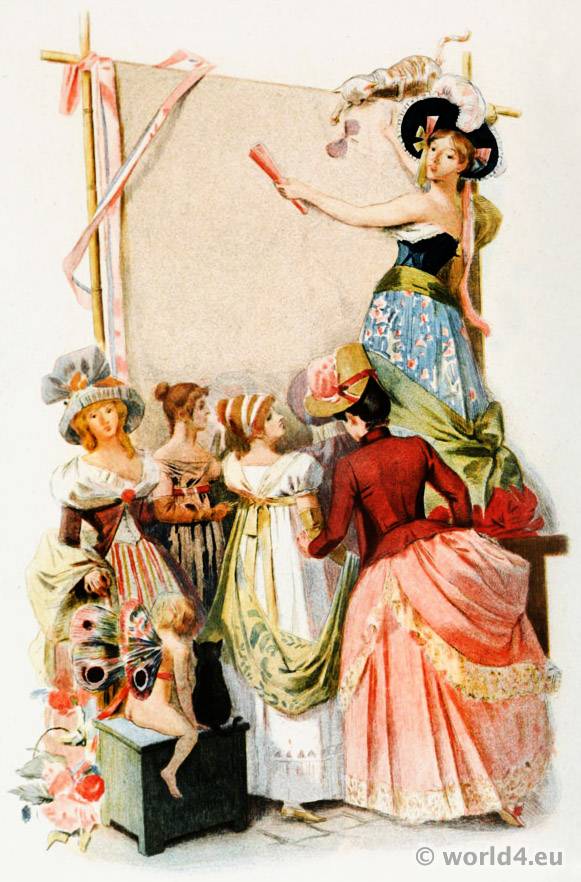
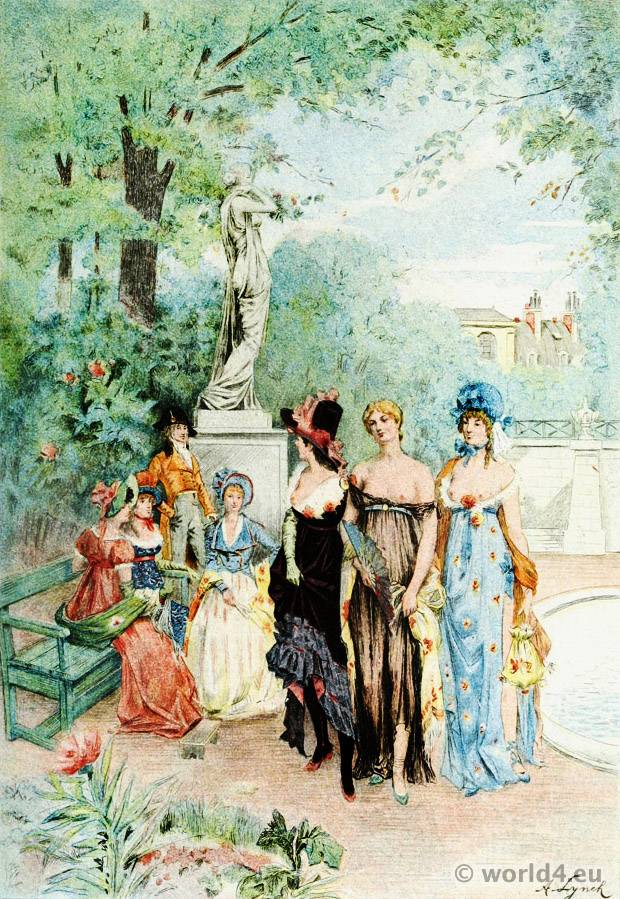
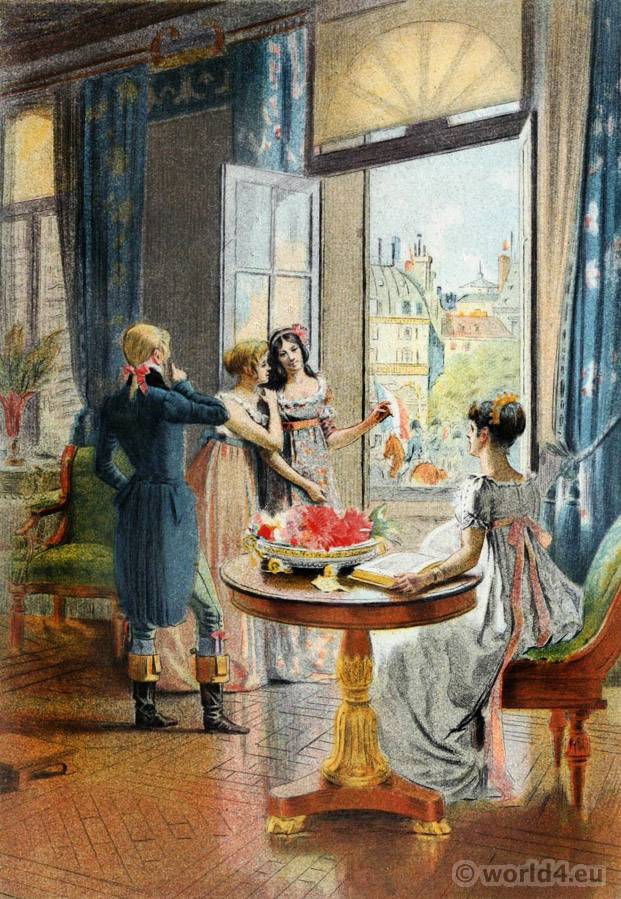
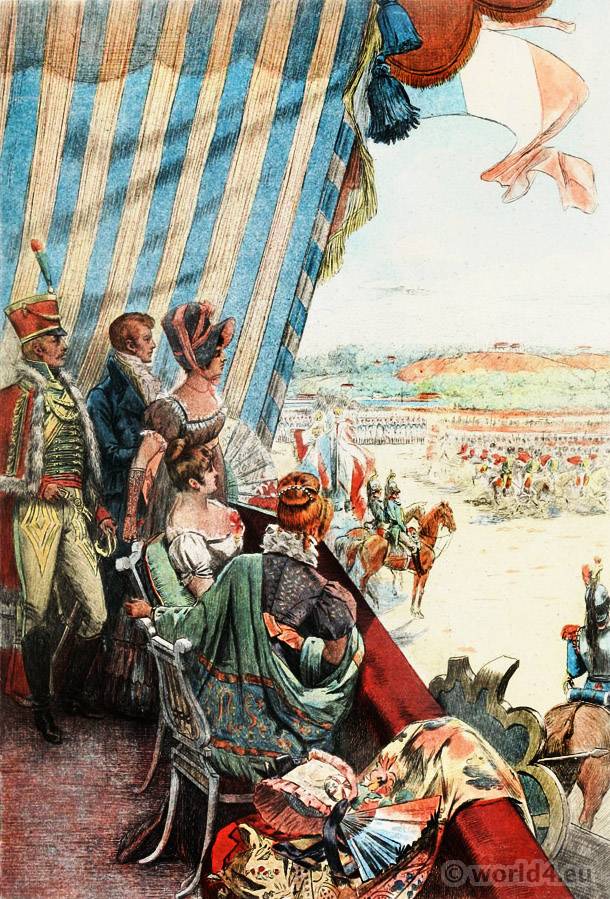
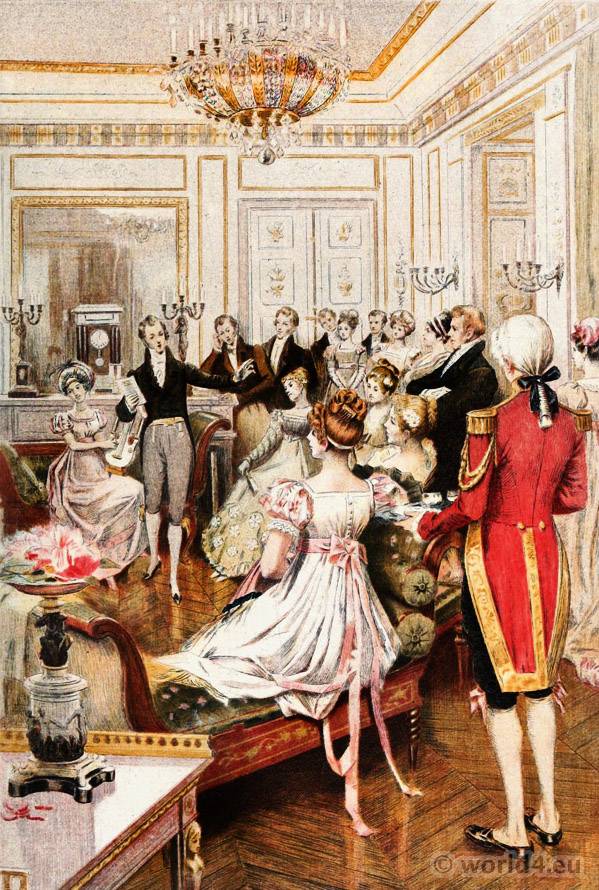
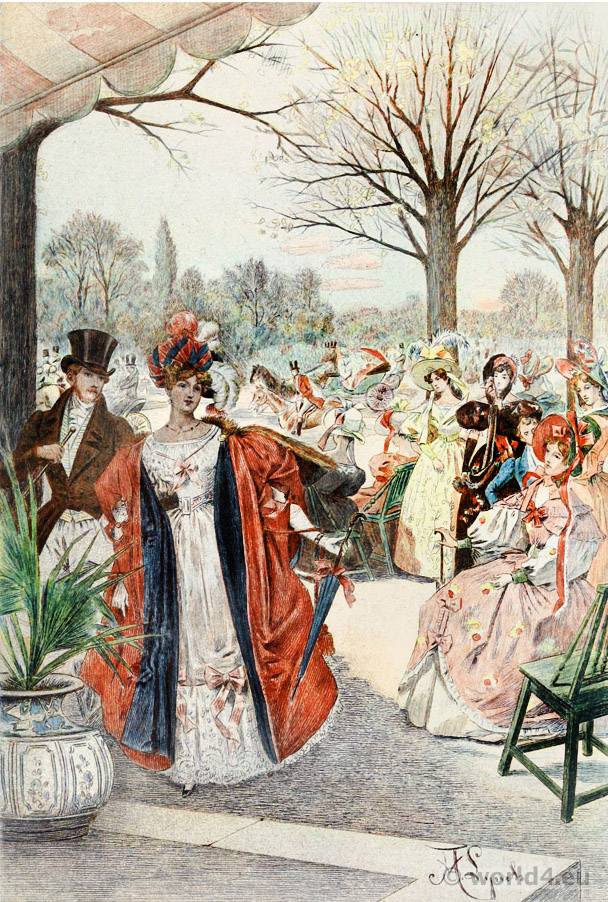
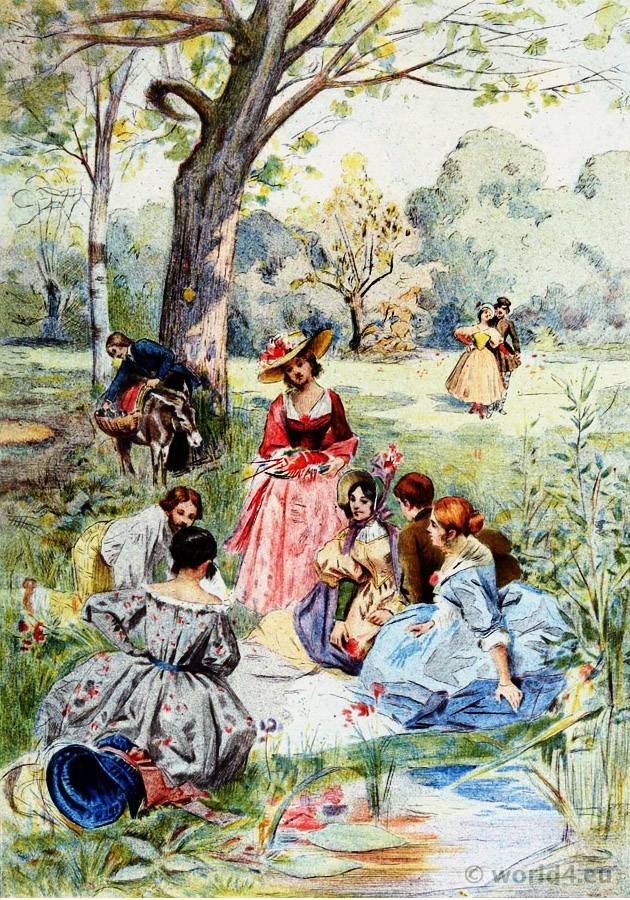
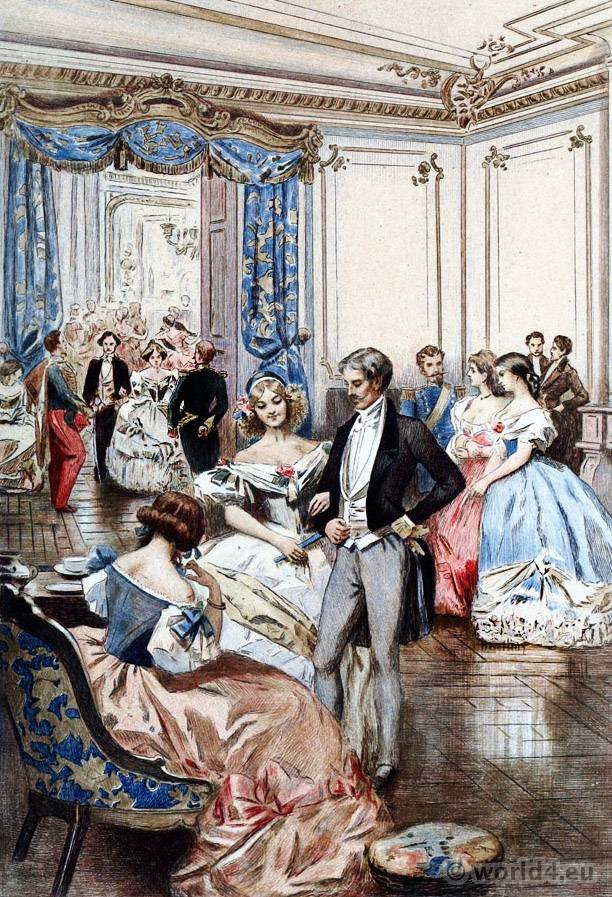
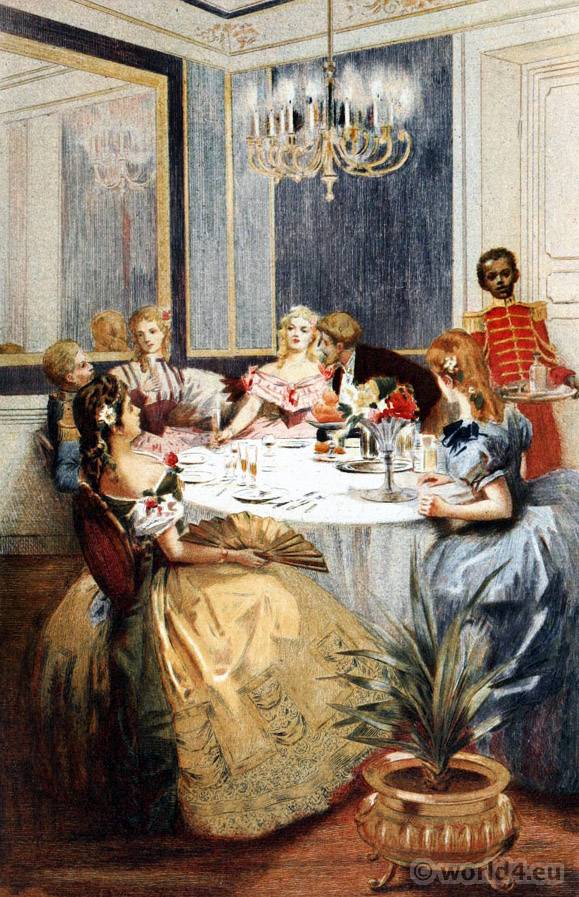
LA FRANÇAISE DU SIÈCLE. MODES – MŒURS – USAGES par Octave Uzanne. Illustrations à l’aquarelle de Albert Lynch, gravées à l’eau-forte en couleurs par Eugène Gaujean. Paris, A. Quantin, imprimeur-éditeur, 1886.

